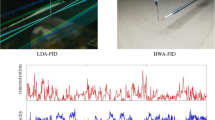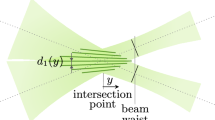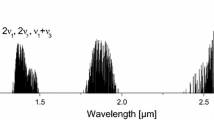Abstract
Accurate measurements in highly turbulent flows, as they occur in nature, require reliable velocity measuring techniques that permit instantaneous velocity components to be locally recorded. Hot-element techniques and optical methods are available for local measurements of instantaneous velocity and the present paper summarizes the advantages and disadvantages of different techniques when applied to flow fields in the environment of vegetation.
The paper points out the advantages of laser-Doppler anemometry for velocity measurements in highly turbulent flows under laboratory conditions and stresses the reliability of the technique for measurements in polluted air and water flows. The basic principles of the method are explained and developments are described that have yielded optical anemometer systems for measurements of the magnitudes and signs of the instantaneous velocity components. Both quantities have to be known if accurate measurements of the mean flow properties and turbulence characteristics in flow fields with unknown flow directions are required. Electronic data-processing systems for laser-Doppler anemometer measurements are surveyed, embracing frequency analysers, automatic filter banks, frequency trackers, photon correlators and frequency counters. Photon-correlation and counting techniques are introduced as the methods most likely to be employed for the laser-Doppler anemometer.
Laser-Doppler anemometer investigations are described in boundary-layer flows along bean leaves and a metal model of plant leaves. These measurements formed the basis of heat and mass transfer predictions near leaves for a specific leaf position relative to the free stream and with different turbulence properties imposed onto the oncoming flow. These data are presented and discussed in some detail. Measurements are also presented that were carried out to investigate the velocity fields in different flow regimes around a square obstacle in a water flow. These flow properties were needed to understand the different growth rates of sea-weed observed in differing flow regimes.
Similar content being viewed by others
Abbreviations
- C f :
-
friction factor
- Fr:
-
Froude number
- f :
-
instantaneous frequency of laser-Doppler signal
- ‡f :
-
frequency fluctuations of laser-Doppler signal
- f I0 :
-
frequency of a light wave scattered in the direction of observation {k o } i from an incident beam in direction {k I }i
- f 0 :
-
frequency of unscattered laser light
- g :
-
gravitation constant
- H :
-
height of flow obstacle
- h :
-
water height in open channel
- {k I } i :
-
unit vector in direction of incident laser beam
- {k I, 1} i , {k I, 2}:
-
unit vectors in direction of incident laser beams 1 and 2
- {k 0} i :
-
unit vector in direction of observation of scattered light
- {k 0, 1} i , {k 0, 2} i :
-
unit vectors in directions 1 and 2 of observed scattered light
- {k R } i :
-
unit vector in direction of reference beam
- {n} i :
-
sensitivity vector of laser-Doppler anemometer, {k I, 1 } i }-{k I, 2 } i ={n i for dual beam anemometer
- Nu x :
-
Nusselt number
- Pr:
-
Prandtl number
- Re x :
-
Reynolds number
- U m :
-
mean velocity in channel flow
- U ∞ :
-
free stream velocity
- û 1,û 2,û 3 :
-
components of instantaneous velocity vector
- U 1,U 2,U 3 :
-
components of mean velocity vector
- u 1,u 2,u 3 :
-
components of fluctuating velocity
- {û} i :
-
instantaneous velocity vector
- U ⊥ :
-
velocity component to which the laser-Doppler anemometer is sensitive
- Ω :
-
open channel width
- α 1,α 2,α 3 :
-
direction angles of vector {n} i
- λ :
-
wavelength of laser light
- ϕ :
-
half-angle between the two laser beams
- Ν :
-
dynamic viscosity of flow medium
- Μ :
-
viscosity of flow medium
- Τ w :
-
wall shear stress
- ϱ :
-
density of flow medium
References
Baker, R. J.: 1974, ‘Use of a Filter Bank Signal Processor for Laser Anemometry’, AERE-R 7652, Harwell, England, March 1974.
Bradbury, L.: 1972, ‘Pulsed Wires and Gauges in a Technique for Velocity and Skin Friction Measurement in Highly Turbulent Flows’, 25th Industrial Aerodynamics Research Meeting, National-Physical Laboratories, Teddington, England.
Buhrer, C. F., Baird, D., and Conwell, E. M.: 1962, ‘Optical Frequency Shifting by Electra-Optics Effect’,Appl. Phys. Letters 1, 46.
Christile, J. C., Burns, J. G., and Ross, M. A. S.: 1973, ‘Development of a Spark Discharge Method of Flow Measurement’,Opto-Electron. 5, 101–106.
Cummins, H., Knable, N., Gampel, G., and Yeh, Y.: 1963, ‘Frequency Shifts in Light Diffracted by Ultrasonic Waves in Liquid Media’,Appl. Phys. Letters 2, 62–64.
Davis, W. and Fox, R. W.: 1967, ‘An Evaluation of the Hydrogen Bubble Technique for the Quantitative Determination of Fluid Velocities Within Clear Tubes’,Trans. ASME, J. Basic Engin. 771–781.
Delft Hydraulic Laboratory: 1969,Current Flow Meters, Technical Description, Holland.
Drain, L. E. and Moss, B. C.: 1972, ‘The Frequency Shifting of Laser Light by Electra-Optic Techniques’,Opto-Electron. 4, 429–439.
Durst, F.: 1972, ‘Development and Application of Optical Anemometers’, Imperial College, London, Ph.D. Thesis.
Durst, F.: 1973, ‘Scattering Phenomena and Their Applications in Optical Anemometry’,Zeitschr. Angew. Math. Phys. 24, 619–643.
Durst, F. and Stevenson, W. H.: 1974, ‘Visual Modeling of Laser-Doppler Anemometer Signals by Means of Moiré Fringes’,Sonderforschungsbereich 80, Universitat Karlsruhe, SFB80/TM/42.
Durst, F. and Whitelaw, J. H.: 1971, ‘Integrated Optical Units for Laser Anemometer’,J. Phys. E: Scientific Instruments 4, 804–808.
Durst, F. and Whitelaw, J. H.: 1973, ‘Light Source and Geometrical Requirements for the Optimization of Optical Anemometer Signals’,Opto-Electron. 5, 137-l51.
Durst, F. and Zaré, M.: 1974, ‘Removal of Pedestals and Directional Ambiguity of Optical Anemometer Signals’,Appl. Optics 13, 2562–2579.
Durst, F. and Zaré, M.: 1975, ‘Optical Developments in Laser Doppler Anemometry’,Sonderforschungsbereich 80, University of Karlsruhe (in preparation).
Eckelmann, H.: 1972, ‘Hot-Wire and Hot-Film Measurements in Oil’, DISA Information No. 13, p. 16.
Goldstein, R. J. and Kreid, D. K.: 1968, ‘Fluid Velocity Measurement from the Doppler Shift of Scattered Laser Radiation’, University of Minnesota, HTL-TR-No. 85.
Hama, F. R.: 1960, ‘The Injection of Dye for Flow Visualization’, ASME Symposium on Flow Visualization, New York.
Herbeck, M.: 1962, ‘Möglichkeit und Grenzen für die Verwendung von Kondensatormikrophonen bei der Messung longitudinaler turbulenter Schwankungen’, Miszellancen der Angewandten Mechanik, Festschrift Walter Tollmien, Akademie Verlag, Berlin.
Hinze, J. O.: 1959, ‘Turbulence’, McGraw-Hill, New York.
Iribarne, A. and Hummel, R. L.: 1969, ‘The Photochromic Visualization of Flows with an Illustration of Pipe Jet’, International Seminar of Heat and Mass Transfer, Herceg-Novi.
Kumar, A. and Barthakur, N.: 1971, ‘Convective Heat Transfer Measurements of Plants in a Wind Tunnel’,Boundary-Layer Meteorol. 2, 218–227.
Macagno, E. O.: 1969, ‘Flow Visualization in Liquids’, IIHR Report No. 114, the University of Iowa.
Mazumder, M. K.: 1970, ‘Laser Doppler Velocity Measurement without Directional Ambiguity by Using Frequency Shifting Incident Beams’,Appl. Phys. Letters 16, 462–464.
Mowbray, D. E.: 1967, ‘The Use of Schlieren and Shadowgraph Techniques in the Study of Flow Patterns in Density-Stratified Liquids’,J. Fluid Mech. 27, 595–608.
Oka, S. and Kostić, Z.: 1972, ‘Influence of Wall Proximity on Hot-Wire Velocity Measurements’, DISA Information No. 13, p. 29.
Perrier, E. R., Robertson, J. M., Millington, R. J., and Peters, D. B.: 1972, ‘Spatial and Temporal Variation of Wind Above and Within a Soybean Canopy’,Agric. Meteorol. 10, 421–442.
Raschke, K.: 1960, ‘Heat Transfer between the Plant and the Environment’,Ann. Rev. Plant Physiol. 11, 111–126.
Stevenson, W. H.: 1970, ‘Optical Frequency Shifting by Means of a Rotating Diffraction Grating’,Appl. Optics 9, 649–652.
Thom, A. S.: 1969, ‘The Exchange of Momentum, Mass and Heat between an Artificial Leaf and the Airflow in a Wind Tunnel’,Quart. J. Roy. Meteorol. Soc. 94, 4455.
Trollinger, J. D.: 1970, ‘Electra/Photo-Optics Instrumentation Applications’, Electra-Optical Systems Design Conference, New York, N.Y., ARO Inc.
Wigley, G.: 1974, ‘Transport in the Boundary Layers of Real and Model Leaves’, University of Nottingham, Ph.D. Thesis.
Yeh, Y. and Cummins, H. Z.: 1964, ‘Localized Fluid Flow Measurements with an He-Ne Laser Spectrometer’,Appl. Phys. Letters 4, 176–178.
Author information
Authors and Affiliations
Rights and permissions
About this article
Cite this article
Durst, F., Zaré, M. & Wigley, G. Laser-Doppler anemometry and its application to flow investigations related to the environment of vegetation. Boundary-Layer Meteorol 8, 281–322 (1975). https://doi.org/10.1007/BF02153554
Received:
Issue Date:
DOI: https://doi.org/10.1007/BF02153554




